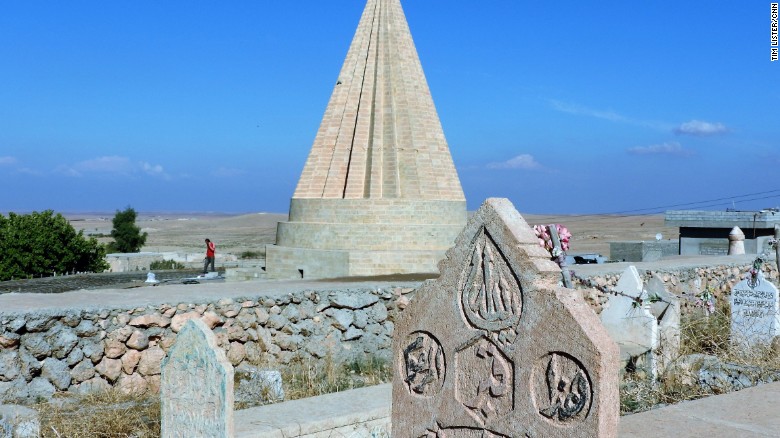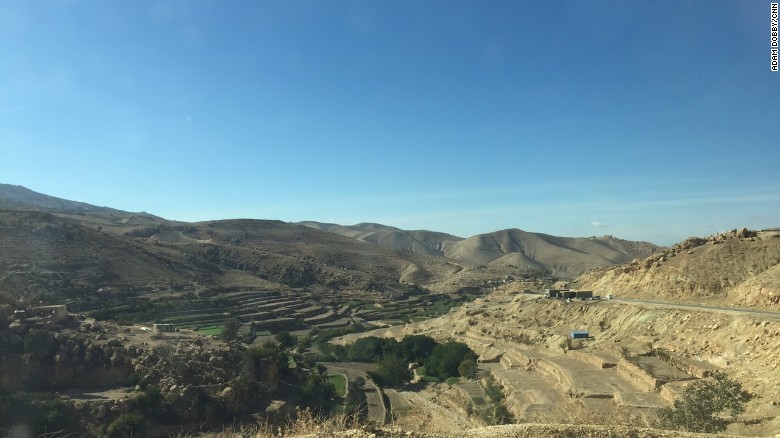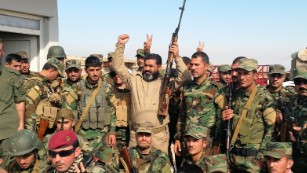ISIS victims returning home, with thirst for revenge
Sharu Baharu, an 80-year-old with a magnificent handle-bar mustache, is facing his second winter on Mount Sinjar, where a bitter wind kicks up as the sun sets over the barren cliffs.
Until last year, he had lived his entire life in the town of Sinjar below.
Then, over a few days during August 2014, 5,000 men and boys in Sinjar and nearby villages were massacred, according to U.N. estimates.
"We fought as long as we could, but we had no weapons and they had so many," Baharu says, gesturing with his index finger for emphasis. "We saw so many killed, but we escaped at night and came to the mountain."

Sharu Baharu, 80, left, fled his home in Sinjar last year when ISIS attacked.
Thousands fled across the mountain and escaped through a narrow corridor forced open by Syrian Kurdish fighters who came to their rescue.
Baharu is a Yazidi, a tiny minority living around Mount Sinjar in Iraq. They are considered heretics by conservative Muslims and were an obvious target for ISIS as it spread across Iraq and Syria.
Baharu recalls how one Arab neighbor, whose family had lived next to his for generations, helped at least 60 Yazidis escape the advancing ISIS convoys.
But another neighbor turned on the Yazidis.
"He raised the Daesh [ISIS] flag and took his gun. He killed nearly 20 people as they tried to leave," Baharu says.
Around him, nine granddaughters play and gaze at the strange visitors. They suffer the cold on Mount Sinjar and have no schooling, but they are lucky to be alive, and the older girls are lucky not to be owned by ISIS fighters.
As many as 7,000 young women and girls were abducted to become sex slaves; even today there are reports of their being sold in the ISIS stronghold of Mosul.
Sinjar is now a chaotic jumble of demolished buildings whose only inhabitants are a few hundred ISIS fighters facing off against small detachments of Kurdish Peshmerga forces.
Yazidi girl remembers horror of helicopter escape from ISIS
ISIS pushed back
But on the other side of the mountain, it is a different story.
The village of Snuny sits in the shadow of Mount Sinjar in northern Iraq, close to the holiest Yazidi shrine.

The holiest Yazidi places are nestled around Mount Sinjar.
It is a dusty, rundown place, surrounded by multiple checkpoints set up by Kurdish Peshmerga forces who drove ISIS from the village in December last year.
The rubble of conflict is everywhere, and even today ISIS positions are only a few kilometers away to the east and west.
In February, when I last visited Snuny, it was empty of civilians.
The last had scribbled appeals like "We need internationally help" before fleeing from ISIS.
It was silent, dark and deserted at night, an outpost of the Peshmerga amid hostile ISIS-held territory.
Now the electricity supply has been restored, there is running water, and the first trickle of Yazidi civilians are returning to the homes that were not blown up by ISIS.
The fields that hug the Syrian border are being plowed; street kiosks sell vegetables, water and rice to Kurdish and Yazidi fighters and the few civilians who have dared come home. There is even a shisha café.
The Yazidis are an ancient people; over the centuries they have been persecuted by or fought against Sunni Arabs, Kurds and a host of other adversaries.
Their children are brought up learning about a history of attempted genocides.
Until ISIS tried to exterminate them, about a half-million Yazidis lived within sight of Mount Sinjar, which looms above the plains of Nineveh and is home to their shrines and ancestral villages.
The Yazidi religion borrows from several traditions, and includes some Islamic beliefs, Persian Zoroastrianism and Mithraism. Its origins are unclear, but it is believed to have emerged in the 12th century when a Sufi Muslim leader called Adi ibn Musafir settled in the area.
'Hundreds' of Yazidi women killing themselves in ISIS captivity
Sleeper cells
Every Yazidi you meet has a harrowing tale. Kji Am Silu lived in the village of Kojo, a few kilometers south of Sinjar. On August 2, 2014, he says, his uncle had welcomed Arabs from nearby villages to a feast.
"The next morning, everywhere we see the black flag of Daesh," he says.
Most of their neighbors had turned against them, encouraged by ISIS sleeper cells.
For the next 10 days the Yazidis of Kojo were under siege, hopelessly outgunned and with no way of escape despite repeated appeals for help from the outside world.
When ISIS finally entered the village, they shot 600 men and abducted as many as 1,000 women and girls.
Silu says he survived because he pretended to be dead under a pile of bodies.
His uncle did not survive.
Silu and other Yazidis say they have no issue with Arabs from Iraq's Anbar province and elsewhere who now share their refugee camp near Dohuk in northern Iraq.
But they cannot imagine ever sharing their villages with the Arabs who turned on them.
"We cannot go back without international protection," Silu says. "We will never be safe."
Sitting next to Silu at the refugee camp is Khalil Jindil, a teacher in his early 50s with a careworn face and a cigarette always between his fingers.
He says he has no faith the Iraqi legal system will bring justice. The word on his lips is revenge. It is a debt of honor to those lost.
Another Yazidi serving in a volunteer battalion on the frontline near Sinjar declares with an icy stare: "When we return to Sinjar, there will be no Daesh prisoners."
There is no mistaking what he means.
ISIS 'forced pregnant Yazidi women to have abortions'
Looming counteroffensive
The operation to retake Sinjar is fast approaching.
At night in Snuny, the yapping of wild dogs competes with the drone of C-130 aircraft and high-pitched murmur of coalition strike planes, invisible thousands of feet above.
The tempo of air strikes against ISIS positions in and around the town has picked up; CNN witnessed one strike against what was described as a vehicle suicide bomb on the outskirts of the town. On Wednesday alone there were nine strikes.

Half a million Yazidis used to live within sight of Mount Sinjar in Iraq.
Sinjar matters existentially to the Yazidis, but it's also important in the wider effort to defeat ISIS.
The artery that passes through the town links Mosul -- ISIS' prized possession -- with cities it holds in Syria. Cutting this route is big one step toward dividing the "Caliphate" that ISIS claims it is establishing.
But the road also carries badly needed supplies to the 1.5 million people who still live in Mosul, where prices are rising and activists report hunger.
The more optimistic Peshmerga commanders think that ISIS fighters will melt away within hours once the attack on Sinjar begins, and retreat to nearby Tal Afar -- another stronghold of the group.
Others fear that the network of tunnels they have built and the landmines and booby-traps they have planted will mean a painstaking street-by-street advance, especially if battle-hardened Chechen fighters are hiding in Sinjar.
And the buildup to the attack has not been entirely smooth.
For the drones and strike aircraft, it is often impossible to distinguish between an ISIS vehicle and other traffic, which has complicated the task of degrading ISIS' presence in the area. According to some accounts, ISIS has even been able to reinforce its defenses in Sinjar.
The timing of the offensive has been further complicated by discord among Kurds from different countries.
The Kurdistan Regional Government in Iraq has told the Syrian Kurdish fighters of the YPG, who are closely allied with the Turkish Kurds of the PKK, to leave the area.
"No need for them here," tweeted Hemin Hawrami, head of foreign relations for the dominant party in Iraqi Kurdistan.
And the Peshmerga Forces' Chief of Staff Lt. Gen. Jamal Mohammed said: "We have already ordered other parties not to intervene."
But the YPG units were still very much in evidence at their checkpoints and small bases around Mount Sinjar early in November, as was their distinct yellow flag with a red star at its center.
They feel they have played the main role in fighting ISIS here and claim that Iraqi Kurdish leader Massoud Barzani wants to claim the glory for recapturing Sinjar.
The Kurdistan Regional Government has been similarly insistent that Yazidi fighters, now numbering some 5,000, fall under Peshmerga command.
As for the Yazidi men themselves, going through their drills at a small camp near the village of Hardan, zero hour cannot come soon enough. But at the same time there is trepidation -- not about the battle soon to begin, but about what they may find in the ruins of their homes.
News Courtesy: www.cnn.com











